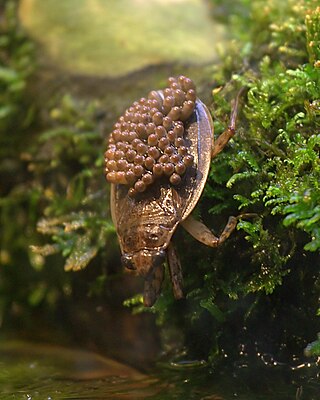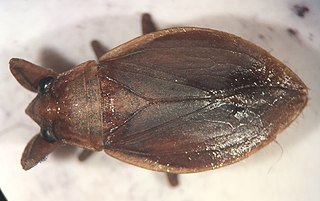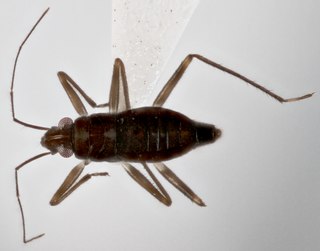
Hemiptera is an order of insects, commonly called true bugs, comprising over 80,000 species within groups such as the cicadas, aphids, planthoppers, leafhoppers, assassin bugs, bed bugs, and shield bugs. They range in size from 1 mm (0.04 in) to around 15 cm (6 in), and share a common arrangement of piercing-sucking mouthparts. The name "true bugs" is often limited to the suborder Heteroptera.

Belostomatidae is a family of freshwater hemipteran insects known as giant water bugs or colloquially as toe-biters, Indian toe-biters, electric-light bugs, alligator ticks, or alligator fleas. They are the largest insects in the order Hemiptera. There are about 170 species found in freshwater habitats worldwide, with more than 110 in the Neotropics, more than 20 in Africa, almost as many in the Nearctic, and far fewer elsewhere. These predators are typically encountered in freshwater ponds, marshes and slow-flowing streams. Most species are at least 2 cm (0.8 in) long, although smaller species, down to 0.9 cm (0.35 in), also exist. The largest are members of the genus Lethocerus, which can exceed 12 cm (4.5 in) and nearly reach the length of some of the largest beetles in the world. Giant water bugs are a popular food in parts of Asia.

Nepomorpha is an infraorder of insects in the "true bug" order (Hemiptera). They belong to the "typical" bugs of the suborder Heteroptera. Due to their aquatic habits, these animals are known as true water bugs. They occur all over the world outside the polar regions, with about 2,000 species altogether. The Nepomorpha can be distinguished from related Heteroptera by their missing or vestigial ocelli. Also, as referred to by the obsolete name Cryptocerata, their antennae are reduced, with weak muscles, and usually carried tucked against the head.

Lethocerus indicus is a giant water bug in the family Belostomatidae, native to South and Southeast Asia, as well as southeast China, the Ryukyu Islands, and New Guinea. It was originally described as Belostoma indicum but is no longer placed in that genus.

Lethocerus deyrollei is a species of giant water bug that traditionally is included in the genus Lethocerus, although recent authorities place it in the Kirkaldyia. They are large, predatory and nocturnal insects. They are one of the best known giant water bugs and are found in Japan, Korea, east China, east Indochina and the Amur region of Russia. They are very common in much of their range, but have declined drastically in some regions and are considered threatened in Japan and Korea. They live in still waters with vegetation, hatching in the summer months and then overwintering half a year later as adults. They primarily feed on small fish, amphibians and aquatic insects, but have also been recorded taking water snakes and young turtles.

Lethocerus is a genus of the hemipteran family Belostomatidae, known colloquially as giant water bugs, toe biters and electric light bugs, distributed in tropical, subtropical and temperate areas of the world. The greatest diversity of species occurs in the Americas, with only a single species in Europe, two in Africa, two in Australia and three in Asia. It includes the largest true bugs with species capable of reaching a length of over 12 centimetres (4.7 in). The South American L. grandis and L. maximus are the only species to commonly exceed 9 cm (3.5 in), with more typical lengths for the remaining species being between 4.5 and 9 cm. Lethocerus sp. are distinguished from other genera in the Lethocerinae by two symmetrical furrows in the inner pad of setae on the fore femur, the external borders of parasternites II and III narrowed and nearly straight, and with the setae of the tarsomeres following the line of the tibial setae.

Lethocerus americanus is a giant water bug in the family Belostomatidae, native to southern Canada and the United States. It typically has a length around 5–6 cm (2.0–2.4 in). It was originally classified as a species in genus Belostoma.

Abedus is a genus of giant water bugs found in freshwater habitats in southern United States, Mexico and Central America. Sometimes called ferocious water bugs, these brown insects typically are between 2.3 and 4 cm (0.9–1.6 in) long, although A. immaculatus only is about 1.3–1.4 cm (0.51–0.55 in), making it the smallest North American belostomatid and possibly worthy of separation in its own genus. Otherwise the different Abedus species are very similar and can often only be separated with a microscope. They will bite in self-defense, which is painful but not dangerous.

Herpetogramma bipunctalis, the southern beet webworm moth or two-spotted herpetogramma, is a species of moth in the family Crambidae. It is found from New England to Florida, west to Texas and north to Illinois. In the south, the range extends through Central America and the Caribbean to South America.

Belostoma flumineum is a North American species of giant water bug. They are a common predator in ponds and wetlands. They are relatively large, reaching 2–2.5 cm (0.79–0.98 in) in length. As with other species of the Belostomatidae family, the fathers take care of the offspring. Exclusive paternal care has been the focus of many studies done on this species. Other studies have been done on food webs and predation pressure using this species because they are an apex predator in their preferred habitats.
Laevapex fuscus, the dusky ancylid, is a species of small, freshwater, air-breathing limpet, an aquatic pulmonate gastropod mollusc or micromollusc in the family Planorbidae, the ram's horn snails and their allies.

Lethocerus patruelis is a giant water bug in the family Belostomatidae. It is native to southeastern Europe, through Southwest Asia, to Pakistan, India and Burma. It is the largest European true bug and aquatic insect. Adult females are typically 7–8 cm (2.8–3.1 in) long, while the adult males are 6–7 cm (2.4–2.8 in).

Belostoma is a genus of insects in the hemipteran family Belostomatidae, known colloquially as giant water bugs. Members of this genus are native to freshwater habitats in the Americas, with the greatest species richness in tropical South America. Most species in the family Belostomatidae have historically been included in Belostoma, but several of these have been moved to other genera. 9 species are claimed to be found in Northern America, but the genus Belostoma is actually divided into 16 subgroups containing about 70 species.

Lethocerus uhleri, or Uhler's water bug, is a species of giant water bug in the family Belostomatidae. It is found in eastern North America from New York, Michigan, and Wisconsin south to Florida and northern Tamaulipas.
Belostoma bakeri is a species of giant water bug in the family Belostomatidae. It is found in Central America and North America.
Belostoma testaceum is a species of giant water bug in the family Belostomatidae. It is found in the eastern United States from New York south to southern Florida and west to Texas and Michigan.

Abedus immaculatus is a species of water bug in the family Belostomatidae. It is the only Abedus species found in the eastern United States, occurring throughout Florida north into Georgia and west along the Gulf Coast to Mississippi.

Benacus is a genus of giant water bug in the hemipteran family Belostomatidae. Benacus is a monotypic genus, containing a single species, B. griseus, which is found in North America. Benacus was formerly considered a subgenus of Lethocerus.

Benacus griseus is a species of giant water bug in the family Belostomatidae. It is the only species in the genus Benacus, which was formerly considered a subgenus of Lethocerus.

Mesovelia polhemusi is a species of water treader in the family Mesoveliidae. It was originally described from Belize and has since been found in southern Florida.















